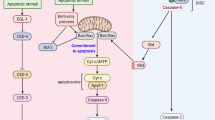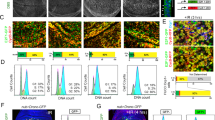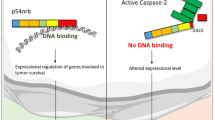Abstract
To dissect the p53-dependent apoptotic pathway, events following induction of temperature sensitive (ts) p53val138 were studied in a Ewing tumor cell line. Transcriptional deregulation of p53 targets first observable after 1 h at 32°C preceded activation of caspases and the break-down of mitochondrial respiratory activity. Activation of caspases was first observed 4 h after p53 induction. Using peptide inhibitors we identified activation of caspase 8 upstream of caspases-9 and -3. Although the caspase 8 specific inhibitor z-IETD.fmk did not affect translocation of BAX to the mitochondrial membrane and cytochrome C release it almost completely blocked cleavage of the prototype caspase substrate PARP and DNA fragmentation while enforcing mitochondrial depolarization and production of reactive oxygene species (ROS). Activation of caspase 8 did not involve death-domain receptor signaling. Expression of BCL2 only partially suppressed caspase activation but blocked apoptosis. Replacement of the N-terminus of p53val138 by the related VP16 transactivation domain created a ts p53 with a tanscriptional activity indistinguishable from p53val138 until the time of caspase activation. However, the VP16–p53 fusion failed to trigger caspases and subsequent induction of the ROS producing gene pig3 paralleled by complete loss of apoptotic activity. These results indicate that p53-dependent transcriptional deregulation, triggering of the caspase cascade and the mitochondrial break-down occur in a timely ordered sequence coordinated by the genuine p53 amino terminus and suggest caspase 8 and PIG3 as key regulatory elements in this process.
This is a preview of subscription content, access via your institution
Access options
Subscribe to this journal
Receive 50 print issues and online access
$259.00 per year
only $5.18 per issue
Buy this article
- Purchase on Springer Link
- Instant access to full article PDF
Prices may be subject to local taxes which are calculated during checkout










Similar content being viewed by others
References
Antonsson B, Conti F, Ciavatta A, Montessuit S, Lewis S, Martinou I, Bernasconi L, Bernard A, Mermod JJ, Mazzei G, Maundrell K, Gambale F, Sadoul R and Martinou JC. . 1997 Science 277: 370–372.
Aragane Y, Kulms D, Metze D, Wilkes G, Poppelmann B, Luger TA and Schwarz T. . 1998 J. Cell Biol. 140: 171–182.
Attardi LD, Lowe SW, Brugarolas J and Jacks T. . 1996 EMBO J. 15: 3693–3701.
Baker SJ, Markowitz S, Fearon ER, Willson JK and Vogelstein B. . 1990 Science 249: 912–915.
Bennett M, Macdonald K, Chan SW, Luzio JP, Simari R and Weissberg P. . 1998 Science 282: 290–293.
Bodmer JL, Holler N, Reynard S, Vinciguerra P, Schneider P, Juo P, Blenis J and Tschopp J. . 2000 Nat. Cell Biol. 2: 241–243.
Bossy-Wetzel E and Green DR. . 1999 J. Biol. Chem. 274: 17484–17490.
Buckbinder L, Talbott R, Velasco-Miguel S, Takenaka I, Faha B, Seizinger BR and Kley N. . 1995 Nature 377: 646–649.
Buckbinder L, Velasco-Miguel S, Chen Y, Xu N, Talbott R, Gelbert L, Gao J, Seizinger BR, Gutkind JS and Kley N. . 1997 Proc. Natl. Acad. Sci. USA 94: 7868–7872.
Caelles C, Helmberg A and Karin M. . 1994 Nature 370: 220–223.
Fernandes-Alnemri T, Armstrong RC, Krebs J, Srinivasula SM, Wang L, Bullrich F, Fritz LC, Trapani JA, Tomaselli KJ, Litwack G and Alnemri ES. . 1996 Proc. Natl. Acad. Sci. USA 93: 7464–7469.
Fiskum G, Craig SW, Decker GL and Lehninger AL. . 1980 Proc. Natl. Acad. Sci. USA 77: 3430–3434.
Friedlander P, Haupt Y, Prives C and Oren M. . 1996 Mol. Cell Biol. 16: 4961–4971.
Fuchs EJ, McKenna KA and Bedi A. . 1997 Cancer Res. 57: 2550–2554.
Fulda S, Scaffidi C, Pietsch T, Krammer PH, Peter ME and Debatin KM. . 1998 Cell Death. Differ. 5: 884–893.
Gao C and Tsuchida N. . 1999 Jpn. J. Cancer Res. 90: 180–187.
Gross A, Jockel J, Wei MC and Korsmeyer SJ. . 1998 EMBO J. 17: 3878–3885.
Hakem R, Hakem A, Duncan GS, Henderson JT, Woo M, Soengas MS, Elia A, de la Pompa JL, Kagi D, Khoo W, Potter J, Yoshida R, Kaufman SA, Lowe SW, Penninger JM and Mak TW. . 1998 Cell 94: 339–352.
Haupt Y, Rowan S and Oren M. . 1995a Oncogene 10: 1563–1571.
Haupt Y, Rowan S, Shaulian E, Vousden KH and Oren M. . 1995b Genes Dev. 9: 2170–2183.
Hirano Y, Yamato K and Tsuchida N. . 1995 Oncogene 10: 1879–1885.
Hsu YT, Wolter KG and Youle RJ. . 1997 Proc. Natl. Acad. Sci. USA 94: 3668–3672.
Hu Y, Benedict MA, Wu D, Inohara N and Nunez G. . 1998 Proc. Natl. Acad. Sci. USA 95: 4386–4391.
Israeli D, Tessler E, Haupt Y, Elkeles A, Wilder S, Amson R, Telerman A and Oren M. . 1997 EMBO J. 16: 4384–4392.
Juo P, Kuo CJ, Yuan J and Blenis J. . 1998 Curr. Biol. 8: 1001–1008.
Kluck RM, Bossy-Wetzel E, Green DR and Newmeyer DD. . 1997 Science 275: 1132–1136.
Kovar H, Aryee DN, Jug G, Henockl C, Schemper M, Delattre O, Thomas G and Gadner H. . 1996 Cell Growth Differ. 7: 429–437.
Kovar H, Auinger A, Jug G, Aryee D, Zoubek A, Salzer-Kuntschik M and Gadner H. . 1993 Oncogene 8: 2683–2690.
Li P, Nijhawan D, Budihardjo I, Srinivasula SM, Ahmad M, Alnemri ES and Wang X. . 1997 Cell 91: 479–489.
Miyashita T and Reed JC. . 1995 Cell 80: 293–299.
Muller M, Scaffidi CA, Galle PR, Stremmel W and Krammer PH. . 1998 Eur. Cytokine. Netw. 9: 685–686.
Owen-Schaub LB, Zhang W, Cusack JC, Angelo LS, Santee SM, Fujiwara T, Roth JA, Deisseroth AB, Zhang WW and Kruzel E. . 1995 Mol. Cell Biol. 15: 3032–3040.
Pietenpol JA, Tokino T, Thiagalingam S, el-Deiry WS, Kinzler KW and Vogelstein B. . 1994 Proc. Natl. Acad. Sci. USA 91: 1998–2002.
Polyak K, Xia Y, Zweier JL, Kinzler KW and Vogelstein B. . 1997 Nature 389: 300–305.
Prasad SC, Thraves PJ, Bhatia KG, Smulson ME and Dritschilo A. . 1990 Cancer Res. 50: 38–43.
Roemer K and Mueller-Lantzsch N. . 1996 Oncogene 12: 2069–2079.
Sabbatini P, Han J, Chiou SK, Nicholson DW and White E. . 1997 Cell Growth Differ. 8: 643–653.
Sabbatini P, Lin J, Levine AJ and White E. . 1995 Genes Dev. 9: 2184–2192.
Salvesen GS and Dixit VM. . 1999 Proc. Natl. Acad. Sci. USA 96: 10964–10967.
Scaffidi C, Schmitz I, Zha J, Korsmeyer SJ, Krammer PH and Peter ME. . 1999 J. Biol. Chem. 274: 22532–22538.
Sheikh MS, Antinore MJ, Huang Y and Fornace AJJ. . 1998a Oncogene 17: 2555–2563.
Sheikh MS, Burns TF, Huang Y, Wu GS, Amundson S, Brooks KS, Fornace AJJ and el-Deiry WS. . 1998b Cancer Res. 58: 1593–1598.
Shimizu S, Narita M and Tsujimoto Y. . 1999 Nature 399: 483–487.
Slee EA, Harte MT, Kluck RM, Wolf BB, Casiano CA, Newmeyer DD, Wang HG, Reed JC, Nicholson DW, Alnemri ES, Green DR and Martin SJ. . 1999 J. Cell Biol. 144: 281–292.
Soengas MS, Alarcon RM, Yoshida H, Giaccia AJ, Hakem R, Mak TW and Lowe SW. . 1999 Science 284: 156–159.
Song Q, Kuang Y, Dixit VM and Vincenz C. . 1999 EMBO J. 18: 167–178.
Takimoto R and El-Deiry WS. . 2000 Oncogene 14: 1735–1743.
Theis S, Atz J, Mueller-Lantzsch N and Roemer K. . 1997 Int. J. Cancer 71: 858–866.
Thornberry NA and Lazebnik Y. . 1998 Science 281: 1312–1316.
Thut CJ, Chen JL, Klemm R and Tjian R. . 1995 Science 267: 100–104.
Unger T, Sionov RV, Moallem E, Yee CL, Howley PM, Oren M and Haupt Y. . 1999 Oncogene 18: 3205–3212.
Varmeh-Ziaie S, Okan I, Wang Y, Magnusson KP, Warthoe P, Strauss M and Wiman KG. . 1997 Oncogene 15: 2699–2704.
Venot C, Maratrat M, Dureuil C, Conseiller E, Bracco L and Debussche L. . 1998 EMBO J. 17: 4668–4679.
Wagner AJ, Kokontis JM and Hay N. . 1994 Genes Dev. 8: 2817–2830.
Wolter KG, Hsu YT, Smith CL, Nechushtan A, Xi XG and Youle RJ. . 1997 J. Cell Biol. 139: 1281–1292.
Wu GS, Burns TF, McDonald ER, Jiang W, Meng R, Krantz ID, Kao G, Gan DD, Zhou JY, Muschel R, Hamilton SR, Spinner NB, Markowitz S, Wu G and el-Deiry WS. . 1997 Nat. Genet. 17: 141–143.
Yang J, Liu X, Bhalla K, Kim CN, Ibrado AM, Cai J, Peng TI, Jones DP and Wang X. . 1997 Science 275: 1129–1132.
Zhan Q, Kontny U, Iglesias M, Alamo I, Yu K, Hollander MC, Woodworth CD and Fornace AJ. . 1999 Oncogene 18: 297–304.
Zhu J, Jiang J, Zhou W, Zhu K and Chen X. . 1999 Oncogene 18: 2149–2155.
Acknowledgements
We thank Drs G Poirier, I Schmitz, B Voitesek, and X Wang for supplying antibodies to PARP, caspase 8, p53 and APAF. We are greatful to Drs J Pietenpol and N Tsuchida for providing BCL-2-, VP16-p53-, and p53val138 expression plasmids. This study was supported in part by grant P12814-GEN from the Austrian Science foundation to H Kovar and by private donations to the Children's Cancer Research Institute.
Author information
Authors and Affiliations
Rights and permissions
About this article
Cite this article
Kovar, H., Jug, G., Printz, D. et al. Characterization of distinct consecutive phases in non-genotoxic p53-induced apoptosis of Ewing tumor cells and the rate-limiting role of caspase 8. Oncogene 19, 4096–4107 (2000). https://doi.org/10.1038/sj.onc.1203780
Received:
Revised:
Accepted:
Published:
Issue Date:
DOI: https://doi.org/10.1038/sj.onc.1203780
Keywords
This article is cited by
-
PCTAIRE3: a putative mediator of growth arrest and death induced by CTS-1, a dominant-positive p53-derived synthetic tumor suppressor, in human malignant glioma cells
Cancer Gene Therapy (2006)
-
The antioxidant function of the p53 tumor suppressor
Nature Medicine (2005)
-
p53 triggers apoptosis in oncogene-expressing fibroblasts by the induction of Noxa and mitochondrial Bax translocation
Cell Death & Differentiation (2003)
-
Response of Ewing tumor cells to forced and activated p53 expression
Oncogene (2003)
-
Mitomycin C induces apoptosis and caspase-8 and -9 processing through a caspase-3 and Fas-independent pathway
Cell Death & Differentiation (2002)



